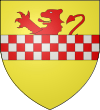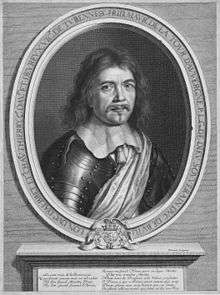Duchy of Bouillon
| Duchy of Bouillon | ||||||||||
| Duché de Bouillon | ||||||||||
| ||||||||||
| ||||||||||
| ||||||||||
.svg.png) The Duchy of Bouillon as at 1560, shown within the Lower Rhenish–Westphalian Circle | ||||||||||
| Capital | Bouillon | |||||||||
| Languages | Walloon | |||||||||
| Government | Dukedom | |||||||||
| Historical era | Middle Ages | |||||||||
| • | Ardennes lords of Bouillon | by the 11th century | ||||||||
| • | La Marck châtelains | from 1415 | ||||||||
| • | First style of Duke | 1456 | ||||||||
| • | Treaties of Nijmegen | 1678 | ||||||||
| • | Abolition of manorial and feudal rights |
26 May 1790 | ||||||||
| • | Ducal constitution | 23 March or 1 May 1792 | ||||||||
| • | Proclamation of the Republic |
24 April 1794 | ||||||||
| • | Annexed to France | 26 October 1795 (4 Brumaire, Year IV) | ||||||||
| Area | ||||||||||
| • | 1790 | 230 km² (89 sq mi) | ||||||||
| Population | ||||||||||
| • | 1790 est. | 12,000 | ||||||||
| Density | 52.2 /km² (135.1 /sq mi) | |||||||||
| ||||||||||
| Today part of | | |||||||||
The Duchy of Bouillon (French: Duché de Bouillon) was a duchy comprising Bouillon in present-day Belgium that existed from the 10th century until 1795, when it was annexed by France. It was controlled by the hereditary Duke of Bouillon.
The state originated in the 10th century as property of the Lords of Bouillon, owners of Bouillon Castle. Crusader Godfrey of Bouillon, later the first King of Jerusalem, sold Bouillon to the Prince-Bishopric of Liège, in 1095. The Prince-Bishops of Liège subsequently became lords of Bouillon and eventually adopted the title of duke. The duchy was later claimed by members of the House of La Marck. After the French annexed Bouillon, the heirs of the last reigning duke, Jacques Léopold de La Tour d'Auvergne, have continued claiming the title.
Geography
.jpg)
The Duchy of Bouillon was a sovereign duchy until 1795. In 1789, it had a population of 2,500. The largest town was Bouillon, situated on the Semois. It also consisted of the surrounding villages: Sugny, Corbion, Alle, Rochehaut, Ucimont, Botassart, Sensenruth, Noirefontaine,[Gros-Fays, Fays-les-Veneurs, Bertrix, Carlsbourg, Paliseul, Jehonville, Opont, Anloy, Porcheresse, Gembes, Gedinne, Sart-Custinne]], and Tellin.
Bouillon is located in a Walloon-speaking region.
History
%3B_le_vieux_pont_sur_la_Semois_et_le_ch%C3%A2teau-fort_(Xe%E2%80%93XVIe_si%C3%A8cles).jpg)
The Duchy of Bouillon's origins are unclear. The first reference to Bouillon Castle comes in 988 and by the 11th century, Bouillon was a freehold held by the House of Ardennes, who styled themselves Lords of Bouillon. On the death of Godfrey III, Duke of Lower Lorraine in 1069, Bouillon passed to his nephew, Godfrey of Bouillon. In 1095, Godfrey of Bouillon sold Bouillon to the Prince-Bishop of Liège, Otbert of Liège in order to finance his participation in the First Crusade. Godfrey later became first ruler of the Kingdom of Jerusalem.
The Prince-Bishop of Liège granted the châtellenie of Bouillon to the House of La Marck in 1415. In 1456, Louis de Bourbon, Bishop of Liège became the first individual to style himself "Duke of Bouillon". In 1482, the Châtelain of Bouillon, William de La Marck, ordered the assassination of Louis de Bourbon, Bishop of Liège in a plot to install his son, Jean de la Marck, as Prince-Bishop of Liège. This plot proved unsuccessful: John of Hornes was elected as successor of Louis de Bourbon as Prince-Bishop of Liège. John of Hornes then fought a war with William de La Marck that ended with the Treaty of Tongeren, signed May 21, 1484, with the de la Marck family relinquishing its claim on Liège, though the de la Marcks retained Bouillon Castle as a pledge. Robert II de la Marck began calling himself "Duke of Bouillon" in 1492, but in 1521, the Prince-Bishop of Liège, Erard de La Marck (a fellow member of the House of La Marck), with the backing of the troops of Charles V, Holy Roman Emperor, managed to regain Bouillon for the Prince-Bishopric.
Robert Fleuranges III de La Marck began styling himself "Duke of Bouillon" in 1526 and all of his successors maintained the right to this title. During the Italian War of 1551–1559, Bouillon was occupied by the forces of Henry II of France to keep them free from Habsburg influence, but Henry II confirmed Robert IV de la Marck as Duke of Bouillon.
From 1560 to 1642, the Dukes of Bouillon were also the rulers of the independent Principality of Sedan.
With the death of Charlotte de La Marck in 1594, the duchy and the title passed to her husband Henri de La Tour d'Auvergne, Duke of Bouillon and thereafter became the possession of the House of La Tour d'Auvergne. France again invaded Bouillon in 1676 during the Franco-Dutch War, but Godefroy Maurice de La Tour d'Auvergne remained Duke of Bouillon. From this point on, although the Duchy of Bouillon was officially still a part of the Holy Roman Empire, it was in actuality a French protectorate. This state of affairs was confirmed by the 1678 Treaties of Nijmegen.
In the wake of the French Revolution, the French Revolutionary Army invaded the Duchy of Bouillon in 1794, creating the short-lived Republic of Bouillon. In 1795, Bouillon was annexed to France.
At the Congress of Vienna, in 1815, the title of "Duke of Bouillon" was restored to Charles Alain Gabriel de Rohan. The Duchy of Bouillon, however, was annexed to the Grand Duchy of Luxembourg, then in personal union with the Kingdom of the Netherlands, becoming part of the Kingdom of the Belgians in 1830.
List of Dukes of Bouillon
House of La Marck, ?–1588
| Picture | Name | Father | Birth | Marriage | Became duke | Death | Spouse |
|---|---|---|---|---|---|---|---|
 |
Robert I de La Marck | Jean de La Marck | 1430 | 15 June 1446 | ? Bouillon raised to a Duchy |
February 1487 | Jeanne de Marley |
 |
Robert II de La Marck | Robert I | 1465 | 25 December 1490 | February 1487 father's death |
March 1536 | Catherine de Croÿ |
 |
Robert Fleuranges de La Marck | Robert II | 1491 | 1 April 1510 | March 1536 father's death |
21 December 1537 | Guillemette of Saarbrücken, Countess of Braine |
 |
Robert IV de La Marck | Robert Fleuranges | 5 January 1512 | 1 March 1539 | 21 December 1537 father's death |
15 February 1556 | Françoise de Brézé, Countess of Maulevrier |
 |
Henri Robert de La Marck | Robert IV | 7 February 1540 | 7 Feb 1558 | 15 February 1556 father's death |
2 December 1574 | Françoise de Bourbon |
 |
Charlotte de La Marck suo jure |
Henri Robert | 5 November 1574 | 19 November 1591 | 2 December 1574 father's death |
15 May 1594 | Henri de La Tour d'Auvergne |
| Picture | Name | Father | Birth | Marriage | Became duke | Death | Spouse |
House of La Tour d'Auvergne, 1588–1802
| Picture | Name | Father | Birth | Marriage | Became duke | Ceased to be duke | Death | Spouse |
|---|---|---|---|---|---|---|---|---|
 |
Henri de La Tour d'Auvergne | François de La Tour d'Auvergne | 28 September 1555 | 19 November 1591 | 15 May 1594 first wife's death |
25 March 1623 | Charlotte de La Marck | |
| 15 April 1595 | Elisabeth of Nassau | |||||||
 |
Frédéric Maurice de La Tour d'Auvergne | Henri | 22 October 1605 | 2 January 1634 | 25 March 1623 father's death |
9 August 1652 | Eleonora Catharina Febronis van den Bergh | |
 |
Godefroy Maurice de La Tour d'Auvergne | Frédéric Maurice | 21 June 1636 | 19 April 1662 | 9 August 1652 father's death |
26 July 1721 | Marie Anne Mancini | |
_while_duc_d'Albret.jpg) |
Emmanuel Théodose de La Tour d'Auvergne | Godefroy Maurice | 1668 | 1 February 1696 | 26 July 1721 father's death |
17 April 1730 | Marie Armande Victoire de La Trémoille | |
| 4 January 1718 | Louise Françoise Angélique Le Tellier | |||||||
| 21 March 1725 | Louise Henriette Françoise de Lorraine | |||||||
 |
Charles Godefroy de La Tour d'Auvergne | Emmanuel Théodose | 16 July 1706 | 2 April 1724 | 17 April 1730 father's death |
24 October 1771 | Maria Karolina Sobieska | |
 |
Godefroy de La Tour d'Auvergne | Charles Godefroy | 26 January 1728 | 27 November 1743 | 24 October 1771 father's death |
3 December 1792 | Louise de Lorraine | |
| |
Jacques Léopold de La Tour d'Auvergne | Godefroy | 15 January 1746 | 17 July 1766 | 3 December 1792 father's death |
1794 Bouillon absorbed into the French First Republic |
7 February 1802 | Hedwig of Hesse-Rotenburg |
| Picture | Name | Father | Birth | Marriage | Became duke | Ceased to be duke | Death | Spouse |
House of Rohan, since 1816
In 1816, the Congress of Vienna restored the title of "Duke of Bouillon", giving it to Charles Alain Gabriel de Rohan, grandson of Marie Louise de La Tour d'Auvergne, who was the daughter of the former duke Charles Godefroy de La Tour d'Auvergne.
| Picture | Name | Father | Birth | Marriage | Became duke | Death | Wife |
|---|---|---|---|---|---|---|---|
 |
Charles Alain Gabriel [1][2][3] |
Henri Louis, Prince of Guéméné (Rohan) |
18 January 1764 | 29 May 1781 | 1816 accession |
24 April 1836 | Louise Aglae de Conflans d'Armentieres |
 |
Louis Victor Mériadec [1][2][3][4] |
Henri Louis, Prince of Guéméné (Rohan) |
1766 | 24 April 1836 accession |
1841 | Berthe de Rohan | |
 |
Camille Philippe Joseph Idesbald [1][2][3] |
Charles-Louis-Gaspard de Rohan-Rochefort Adopted by Louis Victor Mériadec |
19 December 1801 | 28 May 1826 | 1846 accession |
13 September 1892 | Adelheid zu Löwenstein-Wertheim-Rosenberg |
 |
Alain Benjamin Arthur [1][2][3][5][6] |
Arthur de Rohan (1826–1885), son of Camille Philippe | 8 January 1853 | 10 October 1885 | 13 September 1892 accession |
24 February 1914 | Johanna of Auersperg |
 |
Alain Anton Joseph Adolf Ignaz Maria [1][2][3][5][6] |
Alain Benjamin Arthur | 26 Jul 1893 | 29 September 1921 | 24 February 1914 uncles death |
17 March 1975 | Margarethe von Schönburg-Hartenstein |
 |
Karl-Alain Albert Maria [1][2][3][5][6] |
Alain Anton | 1934 | 5 October 1963 | 2 September 1976 accession |
2008 | Ingeborg Irnberger |
 |
Albert Marie [1][2][3][5][6] |
Alain Anton | 12 May 1936 | 2008 accession |
Incumbent | ||
| Picture | Name | Father | Birth | Marriage | Became duke | Death | Wife |
See also
| Wikimedia Commons has media related to Dukes of Bouillon. |


%3B_vue_de_la_partie_occidentale_du_ch%C3%A2teau-fort_(XIIIe%E2%80%93XIX_si%C3%A8cles).jpg)